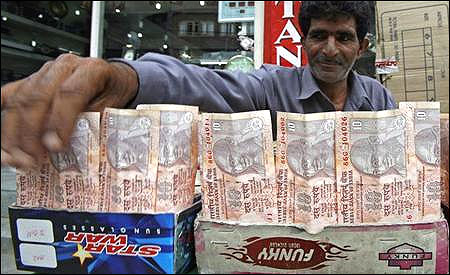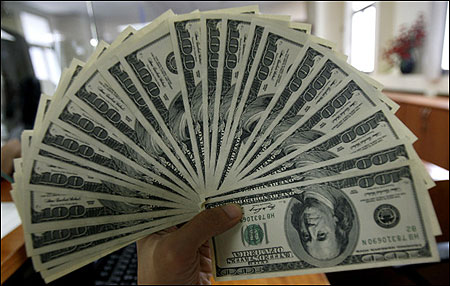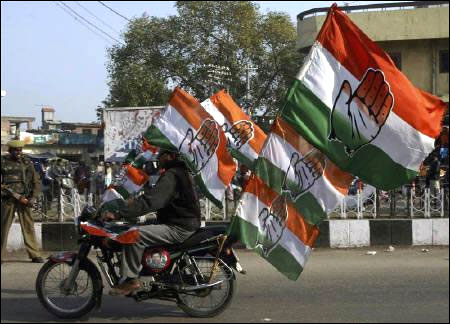 | « Back to article | Print this article |
What the UPA govt can learn from B.E.S.T
Bad economics does not always mean good politics. Its time UPA woke up to that.
"Ek bandra station," I told the conductor of the B.E.S.T (BrihanMumbai Electric Supply and Transport) bus number 83, handing over a ten rupee note.
"Do rupiya aur," he replied.
"12 rupiya ka ticket hai?" I asked him.
"Ji sir," he replied.
I was travelling from Century Bazar in Worli to Bandra. The ticket till very recently used to cost eight rupees. It has now been increased to Rs 12, a rather steep 50 per cent increase.
The prices of tickets of lower denominations haven't been increased so much. A four rupee ticket is now five rupees. But at the same time a ten rupee ticket now costs fifteen rupees and a twelve rupee ticket costs eighteen rupees.
This got me thinking. Why had the B.E.S.T increased prices? Well for the simple reason that they had to match their income with their expenditure, which is the most basic thing that needs to be done for successfully operating any institution.
The fact that it is not allowed to raise prices as often as it probably wants to has led to this very high increase.
While the B.E.S.T believes in at least trying to ensure that its income meets its expenditure, the United Progressive Alliance (UPA) which runs the government of India, doesn't. And this is neither good for the UPA nor for you and me, the citizens of India.
What the UPA govt can learn from B.E.S.T
In the year 2007-2008 (i.e. between April 1, 2007 and March 31,2008) the fiscal deficit of the government of India stood at Rs 1,26,912 crore (Rs 1,269.12 billion).
Fiscal deficit is the difference between what the government earns and what it spends. For the year 2011-2012 (i.e. between April 1, 2011 and March 31, 2012) the fiscal deficit is expected to be Rs 5,21,980 crore (Rs 5,219.80 billion).
Hence the fiscal deficit has increased by a whopping 312 per cent between 2007 and 2012. During the same period the income earned by the government has gone up by only 36 per cent to Rs 796,740 crore (Rs 7,967.40 billion).
Things cannot be quite right when your expenditure is expanding nine times as fast as your income. As Franklin Roosevelt, who was the President of America for a record four times, between 1933 and 1945 famously said "Any government, like any family, can, for a year, spend a little more than it earns. But you know and I know that a continuation of that habit means the poorhouse."
In this document the government gives out numbers for the amount it had assumed initially as the oil subsidy for the year, and the final oil subsidy it gave.
Click on NEXT for more...
What the UPA govt can learn from B.E.S.T
The data for the last three years has been very interesting. The subsidy assumed at the time of the finance minister presenting the budget has always been much lower than the final subsidy bill.
Take the case for the year 2009-2010 (i.e. between April 1, 2009 and March 31,2010) the oil subsidy assumed was Rs 3,109 crore (Rs 31.09 billion).
The final bill came to Rs 25,257 crore {(Rs 252.57 billion) direct subsidies + oil bonds issued to the oil companies}, around eight times more.
The next year (i.e. between April 1, 2010 and March 31, 2011) the oil subsidy assumed was Rs 3,108 crore (Rs 31.08 billion).
The actual bill was nearly 20 times more at Rs 62,301 crore (Rs 623.01 billion). For the year 2011-2012(i.e. between April 1,2011 and March 31,2012) the subsidy assumed was Rs 23,640 crore (Rs 236.4 billion). The actual subsidy bill came to Rs 68,481 crore (Rs 684.81 billion).
So in each of the last three years the oil subsidy bill has come out to be greater than what was assumed. For the current financial year (i.e. April 1, 2012 to March 31,2013) the oil subsidy bill has been assumed to be at Rs 43,580 crore (Rs 435.80 billion).
While this is greater than the assumption made over the last three years, it is highly likely that the oil subsidy bill will come to amount greater than this.
Click on NEXT for more...
What the UPA govt can learn from B.E.S.T
There are two reasons for the same. The first reason is that the rupee has been rapidly depreciating against the dollar and since oil is sold in dollars that means that the Indian companies are paying up more in rupees to buy the same volume of oil.
Currently oil is priced at around $115 per barrel (around 159litres) of oil. This means that Indian companies pay around Rs 6,141 per barrel of oil.
If the rupee falls further and one dollar equals Rs 60 (as has been written about on this website), the Indian companies will be paying Rs 6,900 or 12.4 per cent more per barrel of oil.
In the normal scheme of things this cost would have been passed onto the customer and everybody would have lived happily ever after.
But that is not the case. Various products coming out of oil like kerosene, diesel etc, are heavily subsidized in India.
Hence even with higher prices of oil internationally the Indian oil companies will have to keep selling their products at lower prices and suffer losses. These companies are then compensated for the losses they face by the government of India.
Click on NEXT for more...
What the UPA govt can learn from B.E.S.T
The second reason is that the price of oil is unlikely to go down in dollar terms as well.
As governments and central banks around the world run close to zero interest rates and print more and more money (and are likely to continue to do so) in order to revive economic growth in their respective countries, oil has become a favourite commodity to buy among the speculators.
While central banks and governments can print all the money they want, they can't dictate where it goes.
As Ruchir Sharma writes in Breakout Nations - In Pursuit of the Next Economic Miracles "When money is loose, investors borrow to buy hard assets, which is why the prices of oil, copper, and other commodities have become disconnected from actual demand."
This means that oil will either continue at its current price level or even go up for that matter. And with the rupee likely to depreciate further this means that India's oil import bill is likely go up even further.
It is highly unlikely that this increase in price will be passed onto the end customer. This means that the government will have to bear the losses incurred by the oil companies, pushing up the oil subsidy, which has been assumed to be at Rs 43,580 crore (Rs 435.80 billion).
Click on NEXT for more...
What the UPA govt can learn from B.E.S.T
A higher oil subsidy bill means the government expenditure going up and this in turn means a higher fiscal deficit.
Typically, the government finances this deficit by borrowing money. With the government needing to borrow more money it would have to offer a higher rate of interest.
At the same time a higher government borrowing will crowd out private borrowing, meaning that the private borrowers like banks and other finance companies will have to offer a higher rate of interest on their deposits because there would be lesser amount of money to borrow.
A higher rate of interest on deposits would obviously mean charging a higher rate of interest on loans.
Click on NEXT for more...
What the UPA govt can learn from B.E.S.T
All this can be avoided if the government follows what B.E.S.T did recently i.e. allow oil companies to raise prices of its products.
Why can't a free market operate when it comes to oil products? If the price of oil products changes on a daily basis depending on its international price, like the price of vegetables, people will gradually get used to the idea of a changing price for products like diesel and kerosene.
And of course chances are that with the government borrowing coming down, interest rates might also fall.
In 2007, when the government fiscal deficit was low, a 20 year home loan could be got at an interest rate of 8 per cent.
A loan of Rs 25 lakh (Rs 2.5 million) would mean an EMI(equated monthly installment) of around Rs 25,093. Manybanks are now charging their existing consumers around 13 per cent on their home loans.
This means an EMI of around Rs 35,147 or almost 40 per cent more.
The huge subsidy on oil prices has had a role to play in this increasing EMI. Bad economics does not always mean good politics. Its time UPA woke up to that.
(Vivek Kaul can be reached at vivek.kaul@gmail.com)






